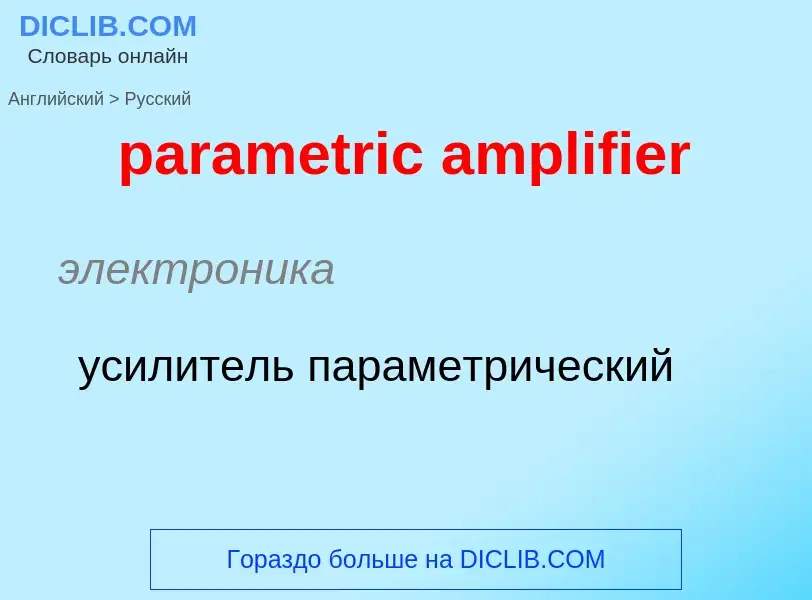Перевод и анализ слов искусственным интеллектом ChatGPT
На этой странице Вы можете получить подробный анализ слова или словосочетания, произведенный с помощью лучшей на сегодняшний день технологии искусственного интеллекта:
- как употребляется слово
- частота употребления
- используется оно чаще в устной или письменной речи
- варианты перевода слова
- примеры употребления (несколько фраз с переводом)
- этимология
parametric amplifier - перевод на русский
электроника
усилитель параметрический
общая лексика
параметрический генератор
математика
параметрический резонанс
общая лексика
каскад усиления
общая лексика
усилитель видеоимпульсов
общая лексика
усилитель напряжения
общая лексика
усилитель звуковой частоты
усилитель низкой частоты
Википедия

A parametric oscillator is a driven harmonic oscillator in which the oscillations are driven by varying some parameter of the system at some frequency, typically different from the natural frequency of the oscillator. A simple example of a parametric oscillator is a child pumping a playground swing by periodically standing and squatting to increase the size of the swing's oscillations. The child's motions vary the moment of inertia of the swing as a pendulum. The "pump" motions of the child must be at twice the frequency of the swing's oscillations. Examples of parameters that may be varied are the oscillator's resonance frequency and damping .
Parametric oscillators are used in several areas of physics. The classical varactor parametric oscillator consists of a semiconductor varactor diode connected to a resonant circuit or cavity resonator. It is driven by varying the diode's capacitance by applying a varying bias voltage. The circuit that varies the diode's capacitance is called the "pump" or "driver". In microwave electronics, waveguide/YAG-based parametric oscillators operate in the same fashion. Another important example is the optical parametric oscillator, which converts an input laser light wave into two output waves of lower frequency ().
When operated at pump levels below oscillation, the parametric oscillator can amplify a signal, forming a parametric amplifier (paramp). Varactor parametric amplifiers were developed as low-noise amplifiers in the radio and microwave frequency range. The advantage of a parametric amplifier is that it has much lower noise than an amplifier based on a gain device like a transistor or vacuum tube. This is because in the parametric amplifier a reactance is varied instead of a (noise-producing) resistance. They are used in very low noise radio receivers in radio telescopes and spacecraft communication antennas.
Parametric resonance occurs in a mechanical system when a system is parametrically excited and oscillates at one of its resonant frequencies. Parametric excitation differs from forcing since the action appears as a time varying modification on a system parameter.



![De Forest's prototype audio amplifier of 1914. The [[Audion]] (triode) vacuum tube had a voltage gain of about 5, providing a total gain of approximately 125 for this three-stage amplifier. De Forest's prototype audio amplifier of 1914. The [[Audion]] (triode) vacuum tube had a voltage gain of about 5, providing a total gain of approximately 125 for this three-stage amplifier.](https://commons.wikimedia.org/wiki/Special:FilePath/First Audion amplifier 1914.jpg?width=200)
![op-amp]] op-amp]]](https://commons.wikimedia.org/wiki/Special:FilePath/LM741CN.jpg?width=200)
![Power amplifier by [[Skyworks Solutions]] in a [[Smartphone]]. Power amplifier by [[Skyworks Solutions]] in a [[Smartphone]].](https://commons.wikimedia.org/wiki/Special:FilePath/Sagem VS4 - Skyworks SKY77328-13-9827.jpg?width=200)
.jpg?width=200)
![McIntosh]] MC240 from 1961 with exposed vacuum tubes McIntosh]] MC240 from 1961 with exposed vacuum tubes](https://commons.wikimedia.org/wiki/Special:FilePath/Mcintosh-MC240-glow.jpg?width=200)
 FIIO Fujiyama for smartphone etc. headphones.jpg?width=200)
![Five rack-mounted audio power amplifiers used in a [[sound reinforcement system]]. Five rack-mounted audio power amplifiers used in a [[sound reinforcement system]].](https://commons.wikimedia.org/wiki/Special:FilePath/Professional PA power amps from Crest Audio and QSC with control modules in rack.jpg?width=200)
![Pyle]] two-channel power amplifier Pyle]] two-channel power amplifier](https://commons.wikimedia.org/wiki/Special:FilePath/Pyle Power Amplifier.jpg?width=200)
![Rear panel of a medium-sized [[sound reinforcement system]] located at one side of the stage at a pop concert. The setup includes the [[mixing console]] for the [[sound engineer]] (standing behind) and the power amplifiers which are partly stacked in a 19-inch rack on the right. Rear panel of a medium-sized [[sound reinforcement system]] located at one side of the stage at a pop concert. The setup includes the [[mixing console]] for the [[sound engineer]] (standing behind) and the power amplifiers which are partly stacked in a 19-inch rack on the right.](https://commons.wikimedia.org/wiki/Special:FilePath/Rear panel of mixing console and amplifiers at concert of band 'Dead Can Dance' in Barcelona, May 2022.jpg?width=200)





